
Ford’s latest Expedition is one great looking full-size SUV, but I’m certain that once you’ve fully read my comprehensive review you’ll be a lot more impressed at what lies beneath its handsome new face and boldly shaped body lines.
Just like generations past, this new fourth-generation Expedition rides on the same body-on-frame platform as the F-Series pickup truck, albeit this time around it’s based on the new T-Platform that underpins the highly advanced, lightweight aluminum-bodied blue-oval workhorse you’ve heard so much about for the last few years.
This full-size Ford SUV received a ground-up redesign for model year 2018, and like the just-noted F-Series it now benefits from its own mostly aluminum skin. The stylish design sits atop a high-strength lightweight boron steel and aluminium frame that further reduces its curb weight by 44 kilograms to 90 kg (depending on trim) when compared its predecessor, or 135 kg when stretched to long-wheelbase Expedition Max lengths, but despite its considerable weight loss the redesigned SUV is more than 100 mm longer than the outgoing version in regular wheelbase form, and 28 mm lengthier in its larger Max body style, while its wheelbase is stretched by almost 90 mm for the regular-length model and 15 mm with the Max, plus it gains more than 25 mm from side to side.
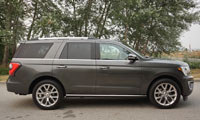
This new regular-wheelbase Expedition’s increased size, plus its lightweight aluminum design are good reasons to consider it over the full-size SUV segment’s best-selling Chevrolet Tahoe/GMC Yukon duo, while all of these truck-based SUVs are more often chosen over their unibody car-based crossover counterparts due to passenger carrying capability and their load hauling/trailering mastery, so additional size is a very good thing in this class.
This newest Expedition’s bigger dimensions allow for an even roomier interior than the previous generation’s sizeable proportions, while the cargo area grows to a maximum of 2,962 litres in regular length, or 3,439 litres with the Expedition Max, the latter providing 477 litres of additional luggage space than the regular Expedition. This means you can load in 4×8 sheets of building material with the tailgate shut.
Some of the Expedition’s additional cargo dimensions include 1,627 litres behind the second row of the regular wheelbase, and 2,077 litres behind that in the Max, or alternatively 1,800 and 2,254 litres respectively for the same area when the second row is slid all the way forward, while lastly it measures 546 litres and 972 litres behind the regular- and long-wheelbase models’ third row respectively, or 593 and 1,019 litres in their rearmost compartments when the third row is fully upright.
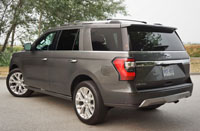
By the way, both second- and third-row seatbacks can be powered upwards and downwards individually from a set of rocker switches on the left-side cargo wall, which is a truly helpful feature in such a big SUV. I should mention here that the two powered rows are only standard with Limited and Platinum trims, whereas this PowerFold feature only benefits the third row in the base XLT model. All rows fold completely flat no matter the trim, however, so you’ll be able to fit all types of cargo inside, while having a better chance of keeping them upright en route.
Compared to the Tahoe/Yukon and Suburban/Yukon XL it’s easy to see the Expedition and Expedition Max are considerably more accommodating, with the GM utilities’ shorter wheelbase model’s 2,682 litres of maximum cargo space shy by a shocking 280 litres, its 1,464-litre capacity aft of its second row falling short by 163 litres, and its 433 litres of luggage space behind the third row off by 160 litres.
As for the Suburban, its 3,446 litres of total luggage volume is actually 7 litres larger than the Max’s maximum (which is more or less a wash), while the 2,172 litres behind its second row make it less accommodating by 82 litres, although the big GM climbs back with 94 litres of additional storage space behind the third row due to 1,113 litres of total cargo capacity.
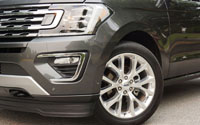
If trailering is more important to your needs, you’ll be happy to learn that the regular wheelbase Expedition shown here can now tow up to 4,218 kilos (9,300 lbs) when outfitted with its $1,400 Heavy-Duty Trailer Tow Package (the base model is good for 4,173 kg or 9,200 lbs with the same upgrade), which is better than its predecessor by 45 kg (100 lbs), plus these numbers are best-in-class by a significant margin. Standard towing features include trailer sway control, which works together with AdvanceTrac traction control and Roll Stability Control (RSC) in order to maintain best-possible command of both SUV and trailer.
Again, putting the Expedition up against the current Tahoe/Yukon shows 3,900 kg (8,600 lbs) of towing capacity, but that’s with the two GM models’ strongest rear-wheel drive layout. The Expedition comes standard with four-wheel drive in Canada, requiring us to compare it to both Tahoe and Yukon 4×4 models that can still only manage 3,810 kg (8,400 lbs) apiece, a whopping 408 kg (900 lbs) less capable than the base Expedition. The Expedition Max tromps all over the Suburban/Yukon XL duo too, its towing maximum of 4,082 kg (9,000 lbs) much more convincing than the two GM utilities’ 3,765 litres (8,300 lbs) in two-wheel drive or 3,629 kg (8,000 lbs) in more directly competitive four-wheel drive. The obvious advantage goes to Ford and its Expedition.
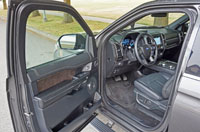
A good reason for the Expedition’s trailering prowess comes down to its updated twin-turbocharged 3.5-litre Ecoboost V6, which is now good for a robust 375 horsepower and 470 lb-ft of torque in base XLT and mid-range Limited trims, the latter version shown here on this page, while an even more formidable version makes 400 horsepower and 480 lb-ft of torque when stuffed under the hood of the top-line Platinum model. These two different versions of this well-proven Ford powerplant come mated to a completely new 10-speed automatic transmission that, improved upon via standard idle start/stop technology capable of automatically turning off the engine when it would otherwise be idling, and then immediately restarting it when lifting your foot from the brake, delivers much greater fuel-efficiency than the previous Expedition.
Once again, comparing the Tahoe/Yukon twins shows a 20-horsepower and 87-lb-ft disadvantage for GM when its two utilities are outfitted with their base 5.3-litre V8 engines, both of which join up with a dependable yet less advanced six-speed automatic transmission, whereas the top-tier GM engine is a gargantuan 6.2-litre V8 that interestingly mates up to a version of the identical 10-speed automatic used for the Expedition (both Ford and GM intelligently developed this sophisticated transmission in unison so as to save costs), this combination allowing for 20 more horsepower than the top-level Ecoboost engine, but alas 20 lb-ft less torque.

Notably, the Expedition’s 10-speed gearbox truly reduces fuel economy, something I witnessed firsthand during my weeklong test. In fact, I had no problem nearing Transport Canada’s official rating of 14.1 L/100km in the city, 10.6 on the highway and 12.5 combined when I eased up on the gas pedal, which compares favourably against the heavier steel-bodied 2017 Expedition that labored along with a comparatively archaic six-speed automatic (just like the current base GM utes) and therefore could only manage 15.9 L/100km in the city, 12.0 on the highway and 14.2 combined in regular length guise. This new lightweight Expedition is much more fuel-friendly than the 2019 Tahoe 4×4’s best rating too, that model only good for 15.8 L/100km in the city, 11.1 on the highway and 13.7 combined, despite the Expedition’s much greater power advantage.
Similarly, the long-wheelbase 2019 Expedition Max enjoys a rating of just 14.7 L/100km in the city, 11.2 on the highway and 13.1 combined, beating its steel-bodied predecessor that could only manage a 16.1, 12.2 and 14.3 rating respectively, whereas the best rating a new Suburban/Yukon XL 4×4 can do is just 16.8 L/100km in the city, 11.3 on the highway and 14.3 combined, which is worse than the previous Expedition Max when driven around town. Also interesting, there’s no noted difference in fuel efficiency when comparing the base 375-hp Ecoboost engine to the more potent 400-hp version, but not so for the larger optional 6.2-litre V8 in the GM utilities that experience a slight increase in consumption to 16.4 L/100km city, 10.7 highway and 13.8 combined, or 17.1, 11.3 and 14.5 respectively.

Together with standard four-wheel drive, the latest Expedition also comes with a version of the Explorer’s terrain management system, which allows a choice of driving styles, plus the capability of maximizing traction on all types of road and trail surfaces, and the ability to set this SUV up to either tow a trailer, or have the Expedition towed behind an even larger vehicle like an RV, all from a rotating dial on the console.
I spent most of my time with the Expedition on pavement, and while doing so found its standard V6 enjoyably smooth, but interestingly a nice V8-like soundtrack complemented the experience. Stomp on the gas pedal and it feels even better than most V8s thanks to all the horsepower and torque noted earlier, so I must admit this would be my personal choice in this segment, unless Ford chose to offer a Powerstroke diesel in the Expedition at some point in the future—fingers crossed.
I think the new 10-speed automatic might be even smoother than the V6. In fact, if it weren’t for all the upward and downward shifts I’d be questioning whether Ford had stuffed a continuously variable gearless box into its transmission housing, but then again it responds much better than a CVT would digging deep into the throttle, at which point it provides nice quick downshifts, albeit never deviating from its silky-smooth demeanor. Also, I never once tried to defeat the auto idle start/stop system mentioned earlier, as it always shut down quickly at stoplights and restarted without hesitation, so why not benefit from the fuel savings?

You might be starting to notice a rather smooth theme as this review moves along, and to that end the Expedition’s suspension is no different. It soaks up dips, bumps and other types of road irregularities no matter the surface below or surrounding weather conditions, and was therefore wonderfully through town, on the highway and most everywhere else, even when testing on a few gravel roads and unkempt trails. I personally think the Expedition is at its best on the freeway, where it’s ability to cruise comfortably all day long is hard to beat, this skill made all the more enjoyable thanks to a capable dynamic cruise control system. This is where I also appreciated the Expedition’s very low road and wind noise.
Another positive is the Expedition’s performance around edgier curves, this partially due to a fully independent multi-link rear suspension setup that especially adds confidence over rough pavement mid-corner. Unlike the Expedition, all directly competitive GM utilities use a comparatively old-school non-independent solid rear axle design.
Despite its size, the Expedition was fairly agile through busy city traffic, this aided by the superb visibility granted by a tall ride-height. Parallel parking downtown, or for that matter trying to find a large enough space in a parking garage, can be a bit challenging, yet most people I know that own one of these full-size SUVs also have a smaller car for zipping around town. If you’re reading this from a rural area, just ignore my inner-city ramblings, as you’ll rarely need to worry about this problem.

Together with the Expedition’s impressive performance and luxurious ride comes an interior that’s improved so significantly since its previous generation that I was truly questioning whether Ford still needed its Lincoln Navigator, at least before spending a week with the latter. Yes, the new Navigator has come a long way too, thanks to real hardwood and plenty of premium materials all around, which more than make up for the $12k or so price premium required to step up to a similarly equipped model. I wouldn’t need all the highfalutin trim in my family hauler, but rather found my Expedition Limited test model wonderfully comfortable.
In fact, its driver’s seat that was about as supportive as this full-size segment gets, only including two-way lumbar support, but to Ford’s credit it powered in and out precisely where it was needed to fill the small of my back, so you won’t hear any complaints from me. I also found the seat’s lower cushion cupped nicely under my knees, but it made me wonder whether those with shorter legs might find this uncomfortable.
Looking back to Expedition Limited materials quality in the cabin, Ford finished off most of the dash top in an attractive, soft-touch stitched and padded leatherette, and continued with this premium material around the sides of the primary gauge cluster, on a separate horizontal strip ahead of the front passenger, and across the tops of the door uppers front and back, while each armrest was well padded too.
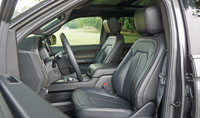
My Limited model’s woodgrain was treated to an authentic looking matte finish, but I have to say Ford didn’t even attempt to make it feel like the real deal. I suppose this is how Ford has detailed out the Expedition since inception, so I doubt anyone will complain, and besides if you want a more luxurious version you can always move up to the new Navigator as I noted before. One item I appreciate more in the Expedition than in the Navigator is its knurled metal rotating gear selector, which is much more intuitive than the newest Lincoln’s row of pushbuttons.
Next to the rotating gear selector is a smaller knurled metal dial for choosing drive modes, filled with Normal, Eco, Sport, Tow/Haul, Mud and Ruts, Sand, and Grass/Gravel/Snow settings. I slotted it into Normal mode most of the time, but found Eco mode just as good for driving through town amid congested traffic, while I’m guessing it helped at the pump too.
Eco mode slows the 10-speed automatic’s shift increments and doesn’t let it hold gears as long, amongst other functions, while when sprinting quickly off the line it still provided plenty of punch. Sport mode, on the other hand, doesn’t allow the auto start-stop function to work and therefore won’t save as much fuel, but the engine was always ready to get up and go from standstill, while the transmission’s shift points were higher within the engine’s rev range, resulting in stronger straight-line acceleration. Also notable, with Sport mode set yet while driving more relaxed, the transmission didn’t merely hold a given gear for no apparent reason, and thus keep engine revs too high. This proved the new 10-speed is a lot smarter than many other multi-speed transmissions I’ve driven.
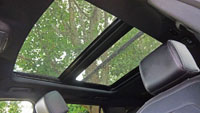
Also good, the gauge cluster’s tachometer dial includes a well-conceived vertical readout showing all 10 gears moving up and down in a cool digital graphic as they slot into place. The two analogue dials bookend a large 8.0-inch standard multi-information display that’s ultra-high in resolution, filled with a stunning array of stylish graphics that wow eyeballs with beautiful contrast and depths of colour. Its functions include an off-road status panel featuring an inclinometer and more, plus a real-time fuel-economy average gauge that displayed a scary 18.3 L/100km while I was taking these notes (which was fortunately not my average throughout the test week), a comprehensive trip mileage panel, some engine information including driving hours and idle hours (my test model showed 209 total hours, of which 63 were idling, so it’s easy to see the need for an idle start-stop system in a vehicle like this), a turbo boost gauge, plus more.
If you haven’t familiarized yourself with Ford’s Sync 3 infotainment touchscreen system then I’m guessing you haven’t read many of my other Ford reviews, because I’ve been an advocate of this system since it debuted a number of years ago. I won’t say it’s still the best in the mainstream volume sector, but I believe it once was and now remains one of the best infotainment systems around, continuing into this latest Expedition with its great looking sky-blue, grey and white minimalist graphics plus easy to understand commands, as well as its bucket-load of useful features that include superbly accurate navigation and, in the case of my test model, a wonderfully helpful parking camera with a regular reverse screen and a separate overhead view.
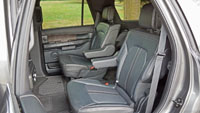
Impressively, each and every Expedition trim comes standard with sensational 12-speaker Bang & Olufsen audio, while this system’s controls are once again comprised of knurled metal dials and tight-fitting buttons. The HVAC system’s controls are equally well designed, featuring temperature readouts within the middle of each dial. Almost all of the Expedition’s switchgear is well made, tightly fitted with minimal spacing, and damped well for a premium experience, with only its steering wheel buttons feeling a bit on the low-rent side.
I wouldn’t go searching for premium-level composite materials below the interior’s beltline either, because Ford didn’t even finish the glove box lid in a padded plastic, but chose a shiny hard shell covering instead. I can imagine some owners might be happier with such hard and more durable plastics, especially along the lower door panels, these feeling rugged enough to withstand kicks aplenty. You won’t need to worry about getting the A-pillar dirty from sooty gloves or unwashed hands either, as Ford didn’t wrap it, or any of the Expedition’s pillars, in fabric. Those wanting a more premium experience should once again be looking up to the Lincoln Navigator.
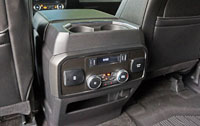
This said the Expedition’s passenger compartment is every bit as spacious as the Navigator’s, or for that matter any other SUV in the full-size class. My test model featured second-row bucket seats instead of the usual three-position bench, with the former providing a wide thoroughfare in between so that children can climb into the rearmost row. Alternatively, you can tilt either bucket forward to access the third row, which might be handier if used by larger teens or adults. The Expedition is actually first in the full-size SUV segment to include this type of a tip-and-slide second-row feature, incidentally—impressive. Also good is a third row that’s at least as comfortable and accommodating as any minivan.
Second-row comfort is even better, plus the fortunate two or three enjoying the Expedition’s mid-section have control of a comprehensive rear automatic HVAC and audio system panel attached to the back of the front console. It includes two USB ports, a three-prong 110-volt household-type plug for a laptop, entertainment/gaming device or whatever else you may want to keep charged up, as well as switchgear for the heatable seats, etcetera. Meanwhile, those third-row passengers noted a moment ago have the ability to use the sidewall-mounted power-folding seat controls to recline their backrests, while they can also plug in devices via optional USB charge points, will benefit from excellent air vents overhead, and enjoy clear views out each large side window, while a gigantic panoramic sunroof provides natural light from above.

Some Expedition technology worth noting includes an available wireless device charger (if you have a smartphone new enough to make use of it), Wi-Fi hotspot capability, and rear-seat entertainment, my tester boasting a monitor on the backside of each front headrest. All in all the Expedition offers up six USB ports, four 12-volt power outlets, and the 110-volt socket just mentioned, while Ford also provides a whopping 17 cupholders throughout.
The base XLT model, starting at $53,978 and set up for eight occupants, gets a lot of standard equipment including a set of 18-inch machine-finished alloys, fog lights, black running boards, black roof rails with black crossbars, Ford’s unique SecuriCode entry keypad, MyKey, an illuminated entry system with approach lamps, pushbutton ignition, rear parking sonar, a leather-clad steering wheel, a windshield wiper de-icer, an eight-way power-adjustable driver’s seat, an auto-dimming centre mirror, a sunglasses holder and conversation mirror within the overhead console, a universal garage door opener, tri-zone auto climate control, the aforementioned Sync 3 infotainment system with Apple CarPlay and Android Auto, a reverse camera system, navigation with detailed mapping, voice control, the 12-speaker Bang & Olufsen audio system mentioned before, satellite radio, power rear quarter windows, flip-up tailgate glass, a cargo management system, power-folding third-row seatbacks, a capless Easy Fuel filler, a Class IV trailer hitch receiver with wiring, tire pressure monitoring, the SOS Post-Crash Alert system, all the normal active and passive safety systems, plus a great deal more.

As-tested Limited trim begins at $65,288 and features 20-inch alloy wheels, a few more chrome exterior trim highlights such as the fog lamp bezels and door handles, bright stainless steel roof rails, LED tail lamps, a remote engine starter, proximity-sensing keyless access, power-deployable running boards in body-colour with polished stainless steel trim, power-folding exterior mirrors with auto-dimming on the driver’s side, ambient interior lighting, the previously noted woodgrain inlays, a power-adjustable steering column, powered foot pedals, driver’s memory, a heated steering wheel, 10-way power-adjustable front seats with heated and ventilated cushions, perforated leather upholstery, the heated second-row outboard seats with Tip-and-Slide and PowerFold capability noted earlier (albeit laid out in a 40/20/40-split bench design), the powered panoramic sunroof, a Connectivity package including the aforementioned wireless smartphone charging, plus a FordPass Connect 4G WiFi modem, and the two smart-charging USB ports in the third row, plus Limited trim also includes yet more first- and second-row (plus cargo area) power points, a foot-activated motion-sensing powered liftgate, front parking sonar, blindspot monitoring with cross-traffic assist, trailer-tow monitoring, etcetera.
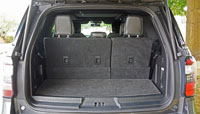
My test model was upgraded with a $5,000 302A package too, enhancing the wheels to 22 inches, adding LED headlights, plus LED fog lamps, and a comprehensive Driver’s Assistance Package that would otherwise cost an additional $1,200 yet adds auto high beams, rain-sensing wipers, dynamic cruise control with stop-and-go, forward collision warning, pre-collision assist autonomous braking and pedestrian detection, lane keeping warning and mitigation, driver alert, the dual-screen surround parking camera noted before, and an enhanced self-parking system.
As mentioned earlier, Platinum trim is top-of-the-line and at $72,552 it includes everything from the 302A package as well as another set of 22-inch alloys, a special satin-finish mesh grille insert, more satin-aluminum exterior detailing such as the mirror housings and door handle accents, upscale brushed aluminum scuff plates on the doorsills, multi-contour front seats like those used for the Navigator (even featuring Active Motion massage), second-row safety seatbelts that self-inflate during an accident, plus more.
Take note that all pricing was sourced right here on CarCostCanada, where you’ll find full detailed information about trims, packages and standalone options, as well as otherwise hard to find rebate information and dealer invoice pricing that could save you thousands.

While there was once a time when $54k to $72k might have seemed like a lot to pay for nothing more than a truck-based SUV, Ford has changed all that with an Expedition that reaches far above its predecessors and most anything else this side of the luxury class, and I must say makes all of its aforementioned GM competitors look like they’re lacking by comparison. When realizing the Tahoe, Yukon, Suburban and Yukon XL all start higher in price than the Expedition, and then factoring in Ford’s more potent and efficient powertrains, more advanced (Land/Range Rover-derived) Terrain Management 4×4 system, more sophisticated fully-independent suspension, lightweight aluminum body, easier third-row access, greater cargo capacity, etcetera, etcetera, there’s no way that combined 2018 calendar year sales of the four GM utilities should be more than four times higher (11,629 Tahoes, Yukons, Suburbans and Yukon XLs to 2,798 Expeditions). It seems that Ford has made up a little ground over the first five months of 2019, with 2,007 deliveries compared to 4,617 unit sales of the GM utes, but the Expedition should still be doing better.
Of course, Ford shouldn’t feel too badly. Its Expedition isn’t suffering from the Nissan Armada’s hardly noticeable 321 unit January through May sales total, or the Toyota Sequoia’s even weaker 248 deliveries over the same five months, while the Explorer is now so good that word is bound to get out to Tahoe, Suburban and Yukon owners that won’t want to feel shortchanged when it comes time to trade in their current rides. We’ll just have to wait to see how GM answers back when it comes time to update the fourth-generation of these four utilities in 2020. Until then, the Ford Expedition is the best this full-size mainstream volume-branded segment has to offer.
Story credit: Trevor Hofmann
Photo credit: Karen Tuggay
